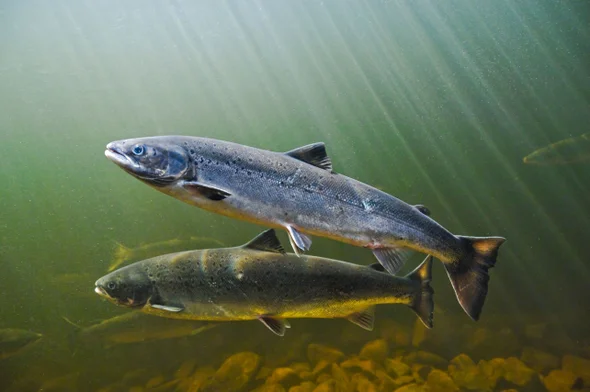In a bid to combat rising water temperatures and help Atlantic salmon populations thrive, scientists have devised innovative methods to “air-condition” rivers and streams. These efforts come as warming waters pose a significant threat to these remarkable fish.
Historically, Atlantic salmon undertook a remarkable journey, with over a million of them returning to Canada’s rivers and streams annually. However, today, that number has dwindled to an estimated 400,000 due to various factors such as acid rain, overfishing, pollution, and damming.
A new threat has now emerged – rising water temperatures, driven by climate change and human water management practices. In some areas, the waters are getting too hot, endangering the fish.
Kathryn Smith, a doctoral candidate at Dalhousie University, Canada, is working on strategies to address this challenge. She has devised two methods to artificially cool rivers and streams, thanks to funding from various organizations.

The first method involves redirecting a portion of a river’s flow through an underground trench to cool the water before it rejoins the main stream. This passive technique reduces water temperatures by a few degrees, offering fish a temporary cool sanctuary.
The second method is more active, where cold groundwater from wells is pumped into rivers, potentially cooling the water by as much as 20 degrees Celsius compared to the river’s temperature.
While Smith has tested these systems in a few sites in Nova Scotia with promising results, her next steps include scaling up the experiments and applying them to various sites across the region.
The work is crucial because temperature plays a significant role in the survival of Atlantic salmon. These fish prefer water temperatures up to 20 degrees Celsius, and they begin seeking cooler spots when it hits 73 degrees Fahrenheit. Once temperatures surpass 80 degrees Fahrenheit, the fish’s chances of survival drop significantly.
Rivers and streams in natural conditions often provide cooler spots for fish to escape the heat. However, human engineering, like dam construction and riverbank armoring, can disrupt streamflow and increase water temperatures. Moreover, climate change is contributing to a steady rise in water temperatures globally.
Kurylyk, a scientist at Dalhousie University, explained that there is empirical data about river warming occurring worldwide. A recent study covering hundreds of rivers in the United States and central Europe found that 87 percent of them experienced persistent warming.
The Nova Scotia Salmon Association has conducted surveys indicating that eastern Canada frequently exceeds the comfortable temperature limits for fish. In many cases, the temperatures become lethal for the fish.
Salmon populations are endangered in parts of Nova Scotia, and further declines are a real concern if these fish struggle to find coldwater refuges in the future.
Projects like Smith’s offer innovative solutions to address these complex issues locally. However, there are scientific questions and challenges to address, such as potential alterations to water chemistry, declining oxygen levels, and the introduction of contaminants.
The feasibility of fish finding and utilizing these artificial cold patches and safeguarding against overfishing in these areas also require careful consideration.
Consultation with various stakeholders, including environmental groups, biologists, government agencies, and Indigenous communities, is vital to ensure that these new water management techniques are effective.
Despite the challenges ahead, Smith’s project is a significant step in developing more resilient systems that can help species persist in the face of global warming. This work is groundbreaking and marks the first successful effort of its kind in Canada. The goal is to equip the world with the tools needed to address the challenges posed by rising temperatures and create environments where these remarkable fish can thrive for the foreseeable future.
Image/Source: ScientificAmerican





